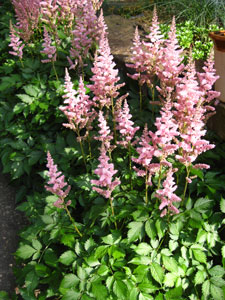Resource Library
Plant of the Week: Chinese Astilbe
The University of Arkansas System Division of Agriculture does not promote, support or recommend plants featured in "Plant of the Week." Please consult your local Extension office for plants suitable for your region.
Plant of the Week
Chinese Astilbe
Latin: Astilbe chinensis

Thank goodness for shade. Our gardens would be a bit less inviting were it not for the canopy of green that filters out the heat and makes the summertime garden a pleasure. However, most summer blooming plants prefer brighter locations and bloom poorly or not at all when grown in shade. Thankfully astilbes are an exception to this generalization.
There are about two dozen astilbe species scattered around the world, with most centered in East Asia. One species is found in the southern Appalachian Mountains from Virginia to Georgia, but it is seldom cultivated. The astilbes most often seen in gardens are the Arends hybrids, a large group of crosses made by German nurseryman Georg Arends during the early years of the 20th century. While these hardy herbaceous perennials of the saxifrage family are great plants available in a variety of colors, they have a reputation for doing best in cooler climates in uniformly moist soils.
The Chinese astilbe (A. chinensis) is native over a wide swath from eastern Russia, through Korea and Japan to the mountains of southwestern China. Of the astilbes, it is probably the best adapted to average garden conditions and is one of the best performers in the South. It grows 2 to 3 feet tall when in bloom and produces a woody crown that expands slowly by short stolons. It has doubly compound leaves, with up to 50 leaflets to 2 inches long that are bright green when mature, but often tinged with maroon flushes when emerging. The foliage dies with the first hard freeze in winter.
Chinese astilbe flowers, at least in the wild forms, are produced in narrow, upright panicles in early summer. Individual flowers are tiny but combined along the panicle branches to create a kind of fat pipe cleaner effect. The typical flower color is a pinkish purple, but modern hybrids are also available in shades of pink and red. Blooms remain at their peak for about two weeks.
Breeding efforts by Dutch nurseryman Win van Veen in the 1990s have resulted in the introduction of ‘Vision in Red’ and ‘Vision in Pink’, two outstanding clones that have sparked new interest amongst shade gardeners in growing astilbes in the South. They are considered suited for planting from zones 3 through 8. A planting of ‘Vision in Pink’ I planted five years ago has proven very free flowering and much more robust than the Arends hybrids I planted about 15 years ago.
Astilbes should be planted in a good well-drained soil that has been enriched with some organic matter. While A. chinensis clones are considered more heat- and drought-tolerant than most astilbes, they should receive normal irrigation during periods of heat and drought. Astilbe will grow in full sun if kept well watered, but medium shade conditions are where they do best. A north or east location in the shade of the home is also ideal. They may be used for massing, as an informal groundcover or as specimens scattered amongst the perennial border.
As long as the plants continue to produce good bloom display, division is not warranted unless additional plants are desired. Divide the plants in early spring, before new growth begins.
By: Gerald Klingaman, retired
Retired Extension Horticulturist - Ornamentals
Extension News - June 10, 2011
The University of Arkansas System Division of Agriculture does not maintain lists of retail outlets where these plants can be purchased. Please check your local nursery or other retail outlets to ask about the availability of these plants for your growing area.